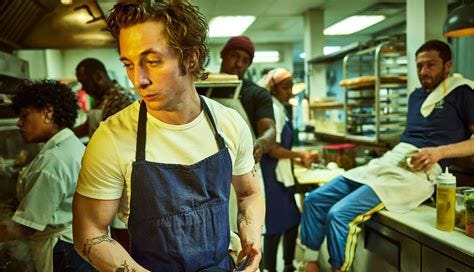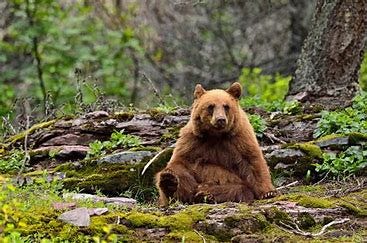Oh The Bear. It’s the new TV darling that’s about to win every award possible (again).
But we’re not here to talk about how great it is. We’re writers, and this is Writers Are Superstars. We’re here to learn from pop culture and The Bear has a lot to teach us.
One of the most obvious lessons we can learn from the series is how it captured a popular cultural zeitgeist—mental health—and created a story that illuminates how that zeitgeist plays out.
I can go on for pages about that, but what I really want to talk about is the character building. Specifically, how episode one of the series sets up the character arc of Carmy—our main character.
I was reading Phillip Pullman’s Daemon Voices and one of the things he says is that the first character you introduce is the first character the audience feels empathy for. It sounds like such an overarching statement, but as I thought about my own novels along with some of the books I’ve read recently, Pullman is actually spot on.
The example he uses in Daemon Voices is that of a thief. He says that if the first scene of a movie is someone stealing and you see the security guard creeping closer, you immediately feel anxious because you think the thief will get caught. You empathize with the thief even though they’re technically doing something wrong and even though you have no context for their actions.
The Bear does something similar. In the opening few scenes, we dive head first into the fire pit of Carmy’s stressful life as a chef. He orders 200 pounds of meat but only 25 pounds show up, we find out right away that the restaurant has serious money issues, and we’re also told that Carmy’s brother has died.
And we can tell by Carmy’s actions that he isn’t handling all of this too well. He’s on the phone trying to make nice with someone he owes money to. He’s running back and forth trying to figure out how to manage the day’s service with not enough ingredients. He literally empties an arcade game that’s inside of the restaurant to see how much money he can grab.
I know all of this sounds like plot, and it is, but it’s also character building. Let me tell you why:
We learn right away that Carmy is a chef. We know he is extremely stressed out and a bit frantic. There’s a scene where he calls another cook, “Chef.” The reaction of the cook shows that she’s never been called that before, at least not under any other boss. What that tells us about Carmy is that respect is important.
In addition to Carmy’s propensity for respect and despite the anxiety he feels because of his job, it’s also blatantly obvious that Carmy has a deep passion for cooking. There’s one moment in the first few minutes that I love because it tells the audience so much. Carmy is cutting carrots (I think they were carrots) and the same cook he called Chef looks at him and says, “You cut carrots like a pussy.”
Carmy doesn’t react, doesn’t even look up. He’s so focused on chopping the carrots properly that you can feel how much he loves to cook.
That’s how you establish a character.
Those small insights and behaviours that on the surface seem meaningless but speak volumes to who that person truly is.
TV shows aren’t books but I believe storytelling principles remain consistent across mediums. And while films may have the visual advantage, we writers have the page. On that page, we can guide readers down any path we choose, and if we do it well, those readers will create images in their own minds that are just as real and even more intimate than those visuals on the screen.
Use that advantage.
In my post last week, I spoke about what I’ve been learning from author R.F. Kuang. There’s a scene early on in her novel, Babel, where the main protagonist, a young, Cantonese boy named Robin, is about to board a ship from China to England. As he’s waiting in line, he overhears an argument between an older Chinese gentleman who doesn’t speak English and the ship’s captain.
The ship’s captain doesn’t want to let the Chinese man on—basically because he’s racist—even though the gentleman has a ticket. While Robin is watching this unfold, he is asked by his guardian to translate so they can hurry the situation ahead.
Robin looks at the man who he feels a natural kinship to. Robin knows the man is right, but he has a decision to make. Either he fights for this gentleman and stands up for what’s right or he concedes. Robin concedes and while he doesn’t tell the gentleman the real reason behind him not being allowed to board the ship, he makes no real attempt to help.
That one moment spoke volumes of who Robin was as a character. And as I kept reading, I saw Robin and his conscience grow. The systemic inequalities finally get to him and he musters up the courage within himself to fight that system.
This is the level of character building we all need to get to.
It’s not just about dialogue and description. We need to put our characters in situations that give readers the opportunity to make a decision on how they feel about that character. Then we need to do it again, and again, and again, and if you’re doing it right, the character should behave differently by the end (or maybe not, but that’s a whole other article).
Another not so subtle approach The Bear takes to build Carmy’s character are flashbacks. A lot of Carmy’s anxiety comes from a specific place, and The Bear takes us back there to give us insight into why Carmy is the way he is. If you remember my post on The Inside Out of Writing Emotional Characters, I list backstory as one of the ways you can help readers connect with your main characters. Flashbacks are a cool and effective way to make that happen, although I will warn you to be careful.
Flashbacks can work in novel writing, but tread carefully. You may be accomplishing your goal of giving backstory, but you’re also pulling your reader away from the present moment. Leaving that immediacy can be jarring, and if you don’t do it right or if you depend too heavily on this type of literary device, you risk losing or confusing your reader.
Referring back to Babel, R.F. Kuang does something quite unique to tell backstory. She uses interludes. She literally titles that section “Interlude” and as a reader, it’s an immediate signal that we are taking a break from the regular plot to dive into the backstory of one of the characters.
These interludes are timed perfectly. They are inserted when one of the side characters makes a plot altering decision and explains to the reader why and how the character arrived at that point. In other instances, the interlude acts as an explainer to a situation that’s playing out in the plot. Once you read it, you better understand that character’s choices.
That said, the interludes are not a replacement for building character. You’ve been with these characters for hundreds of pages before the first interlude is introduced. So Kuang isn’t relying heavily on the interlude. Instead, it feels like a welcomed addition to the story; like a detailed footnote.
I’ve dealt with this in my own novel writing. When the editor for And Then There Was Us first got a hold of my manuscript, it had close to a dozen dream sequences. In my mind, I wanted the entire book to feel like a dream-state. But what my editor told me—and they were right—was that I wasn’t giving readers enough of an opportunity to see how my main character handles situations in real time. This was pulling the character further and further away from the reader and not giving them a chance to connect as deeply as they would if those dream sequences happened in real time.
As important as it is to come up with a cool concept, I don’t think you can truly write a great novel without building full characters, and The Bear is one of the best examples of evolving a character.
TV is so much fun to learn from. What TV shows are you currently watching and what are you learning by watching them?








I have been watching both Hallmark Channels, mysteries and the other one, Christmas in July! They are all reruns but I can't seem to find anything else to watch! I like the old shows like Matlock, Columbo, Diagnosis Murder, etc. I also like watching The Voice and AGT!
What you describe here for The Bear, in my mind, really pays off in the season two finale. All that character building and marinating and then, boom, what it means for that type of person to be locked in the freezer.